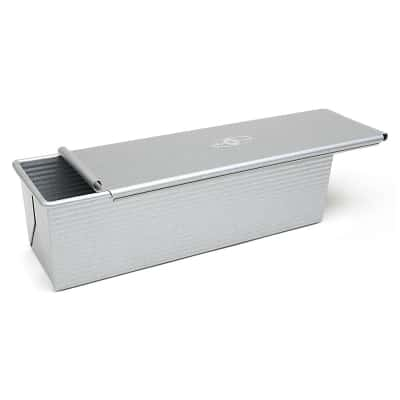A slice of bread is 4.5" wide and typically square in shape.
But, why?
Our story goes back to the beginnings of the 18th-century when bread loaves were hand formed and varied in size from bakery to bakery. Hand-formed loaves have a thick crust, something that customers weren't interested in. Instead, they preferred the "white meat" cake-like interior crumb. In the early 18th century, European bread makers began using pans to minimize crust in a style known as
pain de mie. Once in pans, bread loaves dimensions became more uniform.
Skip forward another century and our story moves to America. There, the Pullman railway company needed a uniform way to bake bread in their compact railway kitchens. To solve the problem, they borrowed the French idea of a baking pan and added a lid to invent a new type of pan that was—you guessed it—4.5" square. These became known as
Pullman Pans and are still in wide use today.
Jump forward another century, to 1912, when Otto Rohwedder of Davenport, Iowa, invented something that forever changed the world we live in: the single loaf bread-slicing machine. And I'll bet you can guess what he used for a loaf size? Yup, loaves baked in the Pullman Pans became the standard for sliced bread. Rohwedder's machine never really took off until Elmer Cline came on board. In 1921, Elmer came up with a new way to market sliced bread. That idea? Making pre-sliced bread loaves available in brightly colored cellophane bags across the country. The marketing slogan for this new bread was "the greatest thing since sliced bread". And the name he chose was
Wonder Bread.
This brings us full circle back to the subject of today's post. Standards. Bread's a standard size so it fits into a standard bread slicer and toaster oven. RCA plugs and XLR plugs are a standard size so they easily interconnect with equipment from any manufacturer.
Standards are critical when it comes to interconnecting products together and playing music of differing mediums. Neither CD players nor vinyl-based turntables would work if the media they play did not adhere to standards.
Standards are a benefit to us all as long as they do not hinder performance or stymie progress. If every piece of audio gear had to conform to the old 600Ω transformer-coupled standards of the broadcast industry, our stereos wouldn't sound as good as they do.
The beauty of standards is interoperability. Their downside is stagnation and restriction.
As long as we're mindful of their upside
and downside, we salute standards.

